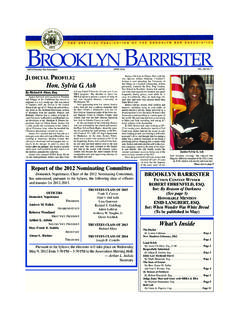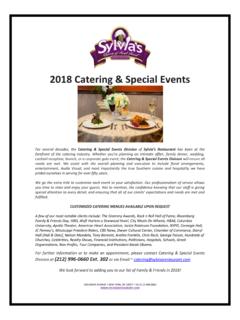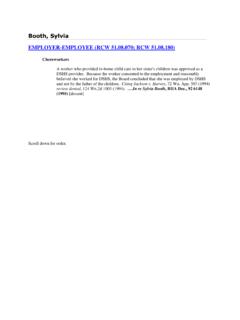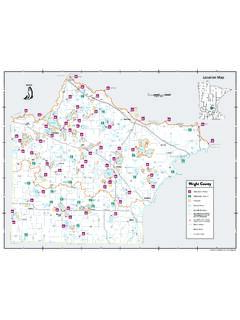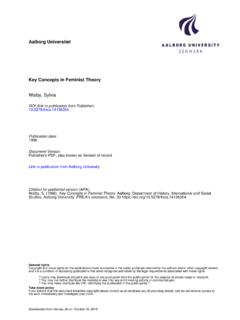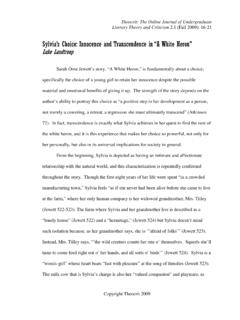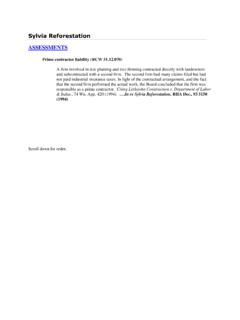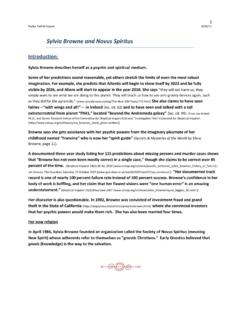Transcription of MATERIAL ENCOUNTERS - Common World
1 MATERIAL ENCOUNTERStMATERIAL ENCOUNTERSCAPILANO UNIVERSITY STUDIO ART GALLERY MARCH 1 19, 2014 CURATED BY sylvia KINDTABLE OF CONTENTS 01 About the Project 03 Experimentation 09 Movement 11 Blocks 15 Paper 19 Charcoal 23 Paint 27 Clay 31 Time 33 Timeliness 35 Acts of Noticing 37 BibliographyWriters Veronica Pacini-Ketchabaw sylvia Kind Laurie Kocher Kelsey Wapenaar Bosun KimPhoto Credits sylvia Kind cover, inside cover, 1-29, 31-38 Katherine Ouellette 21, 25 Veronica Pacini-Ketchabaw 30 Vanessa Clark 30 Adrienne Argent 30 Graphic Design by Kevin Phung Capilano University IDEA programAcknowledgementsVeronica Pacini-Ketchabaw, sylvia Kind, and Laurie Kocher thank the Social Sciences and Humanities Research Council of Canada for generously supporting the research for this exhibit through the grant ENCOUNTERS with Materials in Early Childhood Education.
2 We are also very grateful to the children, educators, and families who have participated in this project, and to those who have graciously assisted with production and installation of the exhibition: Katherine Ouellette, Kelsey Wapenaar, Adrienne Argent, James Armitage, Johanna Po, Lily Wan, and Bosun KimIt has been a wonderful ENCOUNTERS engages with materiality in early childhood education: charcoal, paint, paper, clay, blocks. Materials live in the World in multiple ways. They can evoke memories, narrate stories, invite actions, and communicate meanings. Materials and objects create meeting places. In early childhood education we gather around things to investigate, negotiate, converse, and share.
3 Materials a block of clay, pots of paint, a brush, a colourful wire, a translucent sheet of paper, a rectangular block beckon and draw us in. Materials are not immutable, passive, or lifeless until the moment we do something to them; they participate in our early childhood projects. They live, speak, gesture, and call to early childhood contexts, ENCOUNTERS with materials often find their meaning within the scope of children s development. Processes such as painting with a brush and working with charcoal are seen as activities that contribute to children s social, physical, emotional, and creative development. Materials are described as the bones of curriculum.
4 Instructions on how to organize and arrange materials are frequently provided so that children will learn the materials properties and functions; then, as the children become more familiar with the materials, they use them to shifts in perspective change the nature of our engagement with society and the environment?We are not alone in believing that engaging with materials is urgent today; environmentalists, philosophers, feminists, and others are calling for changes to the capitalist story of materials a story that includes the rampant accumulation of materials as well as massive amounts of trashed materials that are poisoning the planet. These critics argue for the need to develop sustainable caring relationships with the World , including with materials.
5 Materials, they argue, can be more than a commodity for humans to use and discard. MATERIAL ENCOUNTERS aims to rearticulate understandings of materials to formulate what happens when we think with materials. This exhibition proposes ways of thinking about materials in relation to the World that are more sustainable than the ones most children in the Western World experience materials as joint participants in classrooms and children s environments, MATERIAL ENCOUNTERS provides a close look at how paying attention to the force and movements of materials might shift practices in early represent ideas and objects a developmental progression from exploration to representation.
6 As educators, we tend to understand materials from a scientific, rational, or functional viewpoint and through predictable properties of colour, shape, density, mass, friction, and gravity. Further, our understandings of materials are shaped by deeply rooted cultural dichotomies animate/inanimate, active/passive, self/other, to name a few. These binaries lead us, often unconsciously, to think of ourselves as animate agents who act on passive, inanimate materials. This conception then affects how we see materials, how we engage with them, and what we create with them. But what if the human role in shaping materials is not as central as we believe? What if materials shape us as much as we shape them?
7 How might we experience materials differently if we acknowledge them as joint participants in our interactions with them? What happens when we choose to see materials, not as lifeless objects, but as events? How might a shift in perspective on materiality including our own change how we interact with materials, with young children, and with other educators? And how might such education. The exhibition pays attention to a wide range of forces and movements: how materials physically move through time-space, how materials move us both physically and emotionally, how time moves, how air moves, how bodies move, and catalogue and the exhibit work with moments in early childhood classrooms gathered through a visual ethnographic study conducted in two early childhood centres in western Canada over three years.
8 The project s main goal has been to engage in an art-based collaborative inquiry to broaden understandings of the role that materials play in early childhood classrooms. Thinking with materials provokes different ways of thinking about early education. MATERIAL ENCOUNTERS reassembles early education spaces as vibrant social-ecological environments where humans and nonhumans are always in relation. Materials and young children live entangled lives, transforming each other through various ENCOUNTERS . Relationality, therefore, is central to ENCOUNTERS with THE PROJECT3experimentationMaterial ENCOUNTERS is an invitation to invent, create, and experiment.
9 Experimentation is a complex social-affective-political phenomenon that we might embrace in our classrooms to transform tends to focus on human agency. In early childhood education in particular, it focuses on children s expressions and excludes the dynamic role that seemingly inanimate objects play. Yet materials, objects, places, and environments are inextricably bound to experimentation. In this regard, Gilles Deleuze helps us see ENCOUNTERS of materials, objects, places, and humans as part of the flow of experience. In his view, we are never separate from the World ; we are made up of relations; thought creates itself through ENCOUNTERS . For Deleuze, thought is experimentation.
10 Stories are told through it, forces are harnessed, roles are performed. Experimentation opens up worlds, creates new venues for thinking and doing. It actively extends experience. It reveals what human and nonhuman bodies can do and produce when they encounter each other. Through experimentation we discover how something works by relations among the parts of assemblages- structures, flows, and connections. MATERIAL ENCOUNTERS sees teaching and learning as a process of creating what Deleuze called lines of flight. By testing new and unpredictable mixes of bodies, forces, and things, experimentation invents. The process of inquiry into the unknown is embedded in the experimentation of experience with all its unpredictable are not without risk, of course.

